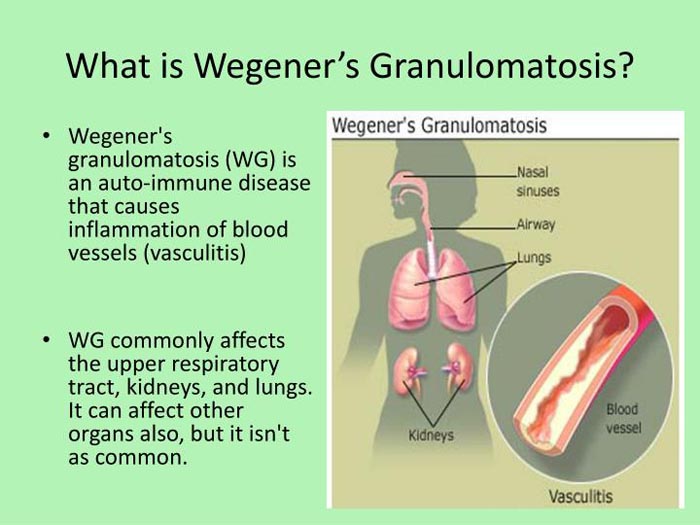
Wegener’s granulomatosis (WG) is a systemic vasculitis, defined by a clinical triad of manifestations that includes involvement of the upper airways, lungs, and kidneys and by a pathologic triad consisting of necrotizing granulomas in the upper respiratory tract and lungs, vasculitis involving both arteries and veins, and glomerulitis.
Causes of Wegener’s Granulomatosis
Immunopathogenesis unclear. Possibly an aberrant hypersensitivity response to an exogenous or endogenous antigen that enters through or resides in upper airways. Clinical symptomatology caused by necrotizing vasculitis of small arteries and veins. Pulmonary involvement: multiple, bilateral, nodular infiltrates. Similar infiltrates in paranasal sinuses, nasopharynx.
Symptoms of Wegener’s Granulomatosis
- voice change
- hoarseness
- shortness of breath
- cough
- Weakness
- Bloody sputum
- Wheezing
- Chest pain
- Rashes
- Joint pains
Diagnosis
Disease triad of necrotizing granulomatous vasculitis of upper and lower respiratory tract associated with glomerulonephritis and c-ANCA.
Treatment
Treatment of Choice Cyclophosphamide Plus prednisone.
Cyclophosphamide 2 mg/kg of body weight per day. Dose should be adjusted to keep leukocyte count >5000/µL (neutrophil count> 1500/µL) to avoid infections associated with neutropenia. Therapy should be continued for 1 year after complete remission, then tapered and discontinued. Alternative drug: azathioprine in similar doses if cyclophosphamide is not tolerated.
Prednisone 1 mg/kg of body weight per day for 1 month, and then changed to alternate-day doses which are tapered and then discontinued after 6 months of therapy.
Trimethoprimsulfamethoxazole as adjunctive therapy and/or prevention of upper airway bacterial infections that promote disease flare.
References